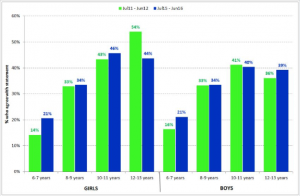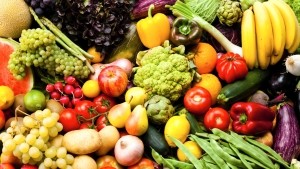This week Down Under
Worrying rise in younger Australian children with body image issues

Though there has been little change between the number of children between six and 13 who were worried about their weight today and four years ago—35% compared to 2012’s 34% for men, and no change in 36% for girls—a worrying new trend has started to emerge.
Closer inspection finds that the proportion of girls aged 6-7 who claim to worry about their weight has risen some 50% from 14% to 21%. Weight concerns have also become more prevalent among girls aged 8-9 (33% to 34%) and those aged 10-11 (43% to 46%).
Offsetting these increases is the dramatic decline among older girls (12-13 years): whereas 54% reported that they worried about their weight in 2012, this has since dropped to 44%.
Perhaps surprisingly, given the traditionally feminine focus of most fat-shaming/weight-watching narratives, a slightly higher proportion of boys aged 6-13 now agree that they worry about their weight (34%) compared to four years ago (32%). This increased concern appears to be driven by boys aged 6-7 (up from 16% to 21%) and those aged 12-13 (36% to 39%).
“The fact that Australia has an obesity problem is well documented, attracting regular media coverage,” said Michele Levine, chief executive of Roy Morgan Research
“The fact that over 35% of kids aged 6-13 are worried about their weight speaks volumes. The striking increase in kids aged between 6 and 7 years worrying about their weight is not a trend that anyone wants to see.”
Fortunately, Levine added that Australian schools are increasingly recognising that body image issues affect both girls and boys from an early age and addressing the subject in the classroom.
“There has been a drastic drop in girls aged 12-13 who are worried about their weight. As they make the transition to high school and adolescence, we can only help this trend continues.”
The research also found that while fewer children are consuming sugary soft drinks, fast food and unhealthy snacks like crisps and chocolate bars than they were four years ago, three in every 10 now agree that they’d rather play computer games than play outside.
More stories from Down Under…
Industry approves of content of code-of-practice review report
New Zealand’s food industry has welcomed the report on the review of a code of practice governing advertising to children.
The review panel, led by Sir Bruce Robertson, has completed its review of the Advertising Standards Authority children’s codes and recommended tighter restrictions in some areas.
Katherine Rich, chief executive of the industry’s representative body, the FGC, says food and grocery manufacturers recognise the need to protect children and will support the final Advertising Standards Authority codes.
“FGC is also working on a new industry advertising pledge under which our members will make overtly clear that they agree to abide by the revised codes.
“This pledge will be a further part of industry’s response to the government’s childhood obesity plan.”
The current code of practice includes a number of common-sense advertising restrictions, such as not encouraging children to eat too much or showing portion sizes that are too big.
It also prohibits using well-known characters to promote food in such a way so as to undermine a healthy diet.
Advertisements for foods high in sugar should not claim to be “low fat” or “fat free”, which could mislead consumers to believe the food is low in energy or beneficial to health.
“Many people may not appreciate how the entire advertising environment in New Zealand has changed dramatically over the past few decades,” said Rich.
Gone are the days of the Milky Bar Kid, Cookie Bear or Crunchie Bar campaigns that aired during children’s TV programming, she added.
Australians not meeting WHO vegetable consumption goals
Most Australians do not meet World Health Organisation standards for vegetable consumption and now research points to a lack of understanding about the nutritional benefits of vegetables, with health benefit labelling potentially providing the answer.
Although there are some notable exceptions—there was a high awareness about some nutritional benefits of carrots (vision) and spinach (iron/energy)—using the carrot rather than the stick might help more people meet the guidelines of approximately five serves a day, according to a Sydney University researcher, Reetica Rekhy.
The findings were published this month in Nutrition & Dietetics by lead author Rekhy under supervision from co-author Robyn McConchie.
Rekhy, from Sydney’s School of Life and Environmental Sciences, said although almost one in two Australians eat the recommended two serves of fruit daily, her survey of 1000 adults found only 6% of adults consumed the recommended serves of vegetables.
“Just knowing you should eat your veggies has not proven sufficient; consumption even in developed countries falls short of the daily intake recommended by the World Health Organisation,” she said.
“It’s possible that with labelling the health benefits of specific vegetables on retail packs, point of sale advertising and other marketing collateral, this could change.”
Although it was generally known that it was important to eat vegetables for health reasons, Rekhy said survey respondents did not have a good understanding about specific nutritional benefits of most vegetables.
Rekhy said the basis for the study was the fact that appropriate vegetable consumption was crucial to reduce the risk of diseases such as cardiovascular conditions, cancers and obesity.
“Some of the most challenging consumers are children. My own experience is to hide it in the food, but also get them to understand that they’re eating delicious vegetables,” the mother of a five-year-old said.











